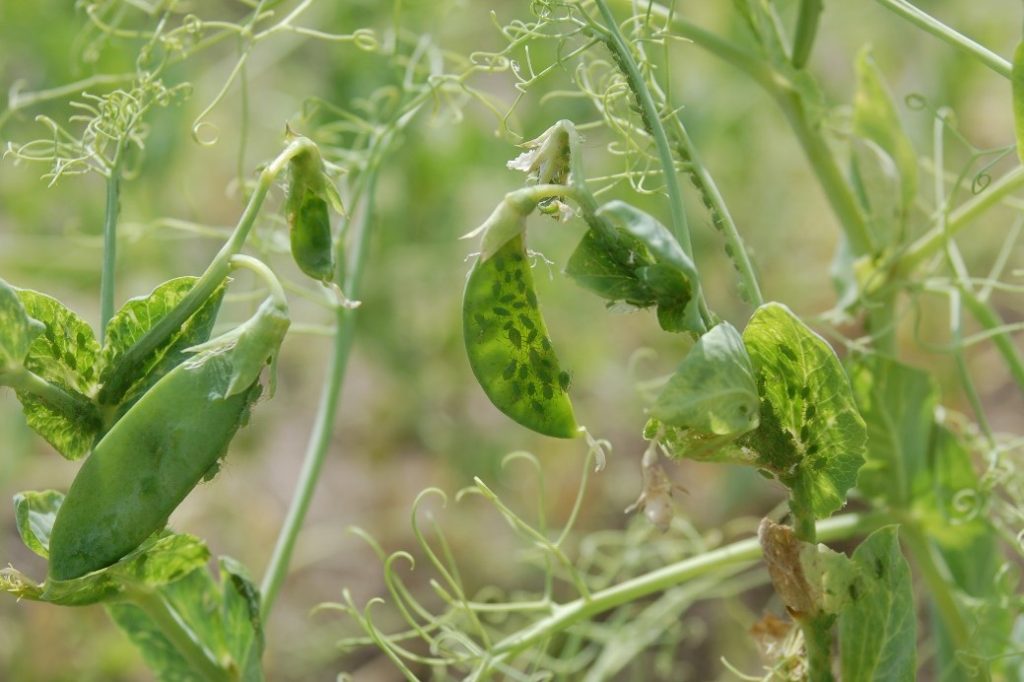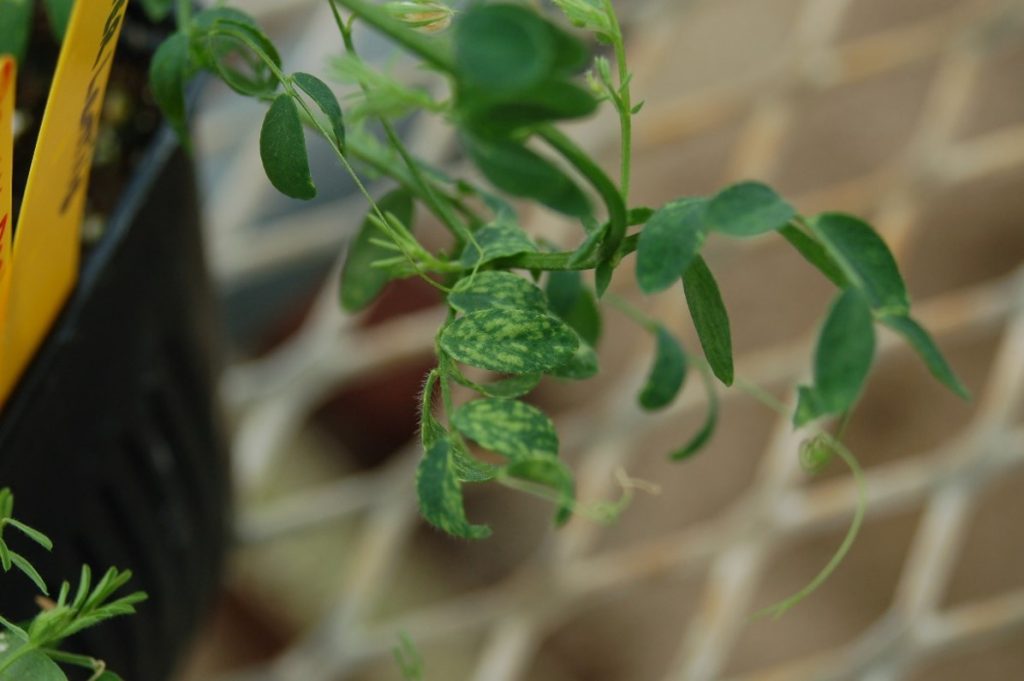Dr. Lyndon Porter, Research Plant Pathologist, USDA-ARS, Prosser, WA
Dr. Mohammad M. Rahman, Horticulture Research Centre, Bangladesh Agricultural Research Centre
Dr. Shimul Das, Agrotechnology Discipline, Life Science School, Khulna University, Bangladesh
The pea aphid (Acyrthosiphon pisum) can be a major issue in dry pea and lentil production areas in the Pacific Northwest, USA. Besides their ability to directly feed on and impact the growth of pea plants, they can also transmit viruses (Figure 1). A single aphid can often carry more than one type of virus and spread two viruses at the same time when feeding. The major viruses transmitted to pea and lentil in the growing areas of Washington State and Idaho are Pea enation mosaic virus (Figures 2 and 3) and Bean leafroll virus (Figure 4). Often symptoms caused by these viruses are mistaken for herbicide damage to these crops. The combination of feeding pressure and virus infection can significantly reduce pea and lentil yields. Aphids have a tremendous reproduction potential as female aphids can reproduce without requiring fertilization by a male (parthenogenesis) and give birth to live offspring that are also female. To manage pea aphids and the viruses they carry, it is paramount to determine pea and lentil lines with genetic resistance to the virus and lines capable of reducing the number of offspring an aphid can produce while feeding on a plant, which can help reduce virus spread and crop feeding damage.
In recent research, we assessed lentil and pea cultivars for their abilities to limit pea aphid reproduction. Lentil cultivars evaluated had total mean aphid counts of 15.5 to 30.7 aphids, after a single aphid was placed on a plant and allowed to reproduce for 10 days (Table 1). Plants in the study were maintained at 70°F and 35% relative humidity in a growth room. In addition to screening the cultivars, an additional 181 lentil lines from the USDA Western Plant Introduction Station located in Pullman, WA were evaluated, and aphid reproduction on these lines ranged from 0.2 to 57 total aphids per plant (data not shown). Of these 181 lentil lines, six lines held aphid reproduction to under 1 aphid in a 10-day period, indicating there are excellent lentil resources with pea aphid resistance that can be used in lentil breeding programs to improve resistance.
Table 1. Mean number of aphids produced on a lentil plant when a single aphid was placed on a plant for 10 days after which the total number of aphids was determined. There were three replications of each cultivar per experiment and the experiment was repeated and results combined.
| Lentil cultivar | Mean total aphids on plant |
| Mason | 30.7±20.7* |
| Pardina | 25.2±7.3 |
| Crimson | 21.8±8.4 |
| Brewer | 21.0±7.0 |
| Red Chief | 19.7±4.0 |
| Palouse | 17.0±8.3 |
| Laird | 15.5±9.0 |
Pea cultivars screened had mostly similar aphid reproduction rates as those of lentil but some cultivars had lower counts than those observed on lentil cultivars. Aphid reproduction on pea cultivars assessed in Table 2 ranged from 2.2 to 25.2 aphids/plant. The cultivar ‘Lifter’, which had the lowest rate of 2.2 aphids/plant, is also resistant to Pea enation mosaic virus and is highly tolerant to Bean leafroll virus. Lifter has tremendous potential as a breeding parent to improve genetic resistance to problematic viruses in the Pacific Northwest, while also helping to reduce pea aphid reproduction rates to reduce epidemic potentials. An additional 291 pea lines from the USDA Western Plant Introduction Station were assessed for pea aphid resistance (data not shown). Of these, only one line reduced aphid reproduction, after a 10-day period, to under three aphids. The rest of the pea lines had rates that ranged from 4 to 59.5 aphids. It appears there are better breeding lines available to breed for pea aphid resistance in lentil than in pea. This research discovered genetic resources capable of making significant advances in pulses to pea aphid resistance.
Table 2. Mean number of aphids produced on a pea plant when a single aphid was placed on a plant for 10 days after which the total number of aphids was determined. There were three replications of each cultivar per experiment and the experiment was repeated and results combined.
| Pea cultivar | Mean total aphids on plant |
| Ariel (Spring green dry pea) | 25.3±5.4* |
| Granger (Austrian winter pea) | 24.8±11.5 |
| Banner (Spring green dry pea) | 22.8±2.8 |
| Majoret (Spring green dry pea) | 18.0±3.8 |
| Shawnee (Spring yellow dry pea) | 17.8±2.5 |
| Bistro (Spring fresh green pea) | 17.3±4.7 |
| Stirling (Spring green dry pea) | 16.7±3.7 |
| Columbian (Spring green dry pea) | 15.3±3.1 |
| Bolero (Spring fresh green pea) | 12.3±5.6 |
| Lifter (Spring green dry pea) | 2.2±1.5 |
*Numbers followed by ± standard error.

Figure 1. Pea aphids colonizing a pea cultivar in a farmer’s field during an aphid epidemic in the Palouse growing region of Idaho. Colonized pea plants have foliar symptoms of Pea enation mosaic virus.

Figure 2. Pea enation mosaic virus symptoms on lentil leaves.

Figure 3. Pea enation mosaic virus symptoms on pea leaves.

Figure 4. Bean leafroll virus symptoms on pea. Notice the yellow, curled new foliage at the top of the plant.


